The Effect of Stimuli Level on Distortion Product Otoacoustic Emission in Normal Hearing Adults
Abstract
:1. Introduction
2. Materials and Methods
2.1. Data Collection
2.2. Data Analysis
3. Results
3.1. Generator Component
3.2. Reflection Component
4. Discussion
5. Conclusions
Funding
Informed Consent Statement
Data Availability Statement
Acknowledgments
Conflicts of Interest
Abbreviations
| ANOVA | Analysis of Variance |
| BM | Basilar Membrane |
| DPOAE | Distortion Product Otoacoustic Emission |
| EL | Equal-Level |
| I/O | Input/Output |
| Op | Optimal |
| Sc | Scissors |
| SNR | Signal to Noise Ratio |
| SOAE | Spontaneous Otoacoustic Emission |
References
- Stover, L.; Gorga, M.P.; Neely, S.T.; Montoya, D. Toward optimizing the clinical utility of distortion product otoacoustic emission measurements. J. Acoust. Soc. Am. 1996, 100, 956–967. [Google Scholar] [CrossRef]
- Janssen, T.; Kummer, P.; Arnold, W. Growth behavior of the 2 f1- f2 distortion product otoacoustic emission in tinnitus. J. Acoust. Soc. Am. 1998, 103, 3418–3430. [Google Scholar] [CrossRef]
- Abdala, C. A longitudinal study of distortion product otoacoustic emission ipsilateral suppression and input/output characteristics in human neonates. J. Acoust. Soc. Am. 2003, 114, 3239–3250. [Google Scholar] [CrossRef] [PubMed]
- Abdala, C.; Keefe, D.H. Effects of middle-ear immaturity on distortion product otoacoustic emission suppression tuning in infant ears. J. Acoust. Soc. Am. 2006, 120, 3832–3842. [Google Scholar] [CrossRef]
- Keefe, D.H.; Abdala, C. Theory of forward and reverse middle-ear transmission applied to otoacoustic emissions in infant and adult ears. J. Acoust. Soc. Am. 2007, 121, 978–993. [Google Scholar] [CrossRef] [Green Version]
- Naghibolhosseini, M. Estimation of Outer-Middle Ear Transmission Using DPOAEs and Fractional-Order Modeling of Human Middle Ear; CUNY Academic Works Database; City University of New York: New York, NY, USA, 2015. [Google Scholar]
- Naghibolhosseini, M.; Long, G.R. Estimation of round-trip outer-middle ear gain using DPOAEs. J. Assoc. Res. Otolaryngol. 2017, 18, 121–138. [Google Scholar] [CrossRef] [PubMed] [Green Version]
- Gehr, D.D.; Janssen, T.; Michaelis, C.E.; Deingruber, K.; Lamm, K. Middle ear and cochlear disorders result in different DPOAE growth behaviour: Implications for the differentiation of sound conductive and cochlear hearing loss. Hear. Res. 2004, 193, 9–19. [Google Scholar] [CrossRef]
- Talmadge, C.L.; Tubis, A.; Long, G.R.; Piskorski, P. Modeling otoacoustic emission and hearing threshold fine structures. J. Acoust. Soc. Am. 1998, 104, 1517–1543. [Google Scholar] [CrossRef] [PubMed]
- Mauermann, M.; Uppenkamp, S.; van Hengel, P.W.; Kollmeier, B. Evidence for the distortion product frequency place as a source of distortion product otoacoustic emission (DPOAE) fine structure in humans. I. Fine structure and higher-order DPOAE as a function of the frequency ratio f2/f1. J. Acoust. Soc. Am. 1999, 106, 3473–3483. [Google Scholar] [CrossRef] [PubMed]
- Shera, C.A.; Guinan, J.J. Evoked otoacoustic emissions arise by two fundamentally different mechanisms: A taxonomy for mammalian OAEs. J. Acoust. Soc. Am. 1999, 105, 782–798. [Google Scholar] [CrossRef]
- Talmadge, C.L.; Tubis, A.; Long, G.R.; Tong, C. Modeling the combined effects of basilar membrane nonlinearity and roughness on stimulus frequency otoacoustic emission fine structure. J. Acoust. Soc. Am. 2000, 108, 2911–2932. [Google Scholar] [CrossRef]
- Gorga, M.P.; Dierking, D.M.; Johnson, T.A.; Beauchaine, K.L.; Garner, C.A.; Neely, S.T. A validation and potential clinical application of multivariate analyses of DPOAE data. Ear Hear. 2005, 26, 593–607. [Google Scholar] [CrossRef]
- Talmadge, C.L.; Long, G.R.; Tubis, A.; Dhar, S. Experimental confirmation of the two-source interference model for the fine structure of distortion product otoacoustic emissions. J. Acoust. Soc. Am. 1999, 105, 275–292. [Google Scholar] [CrossRef] [PubMed] [Green Version]
- Knight, R.D.; Kemp, D.T. Indications of different distortion product otoacoustic emission mechanisms from a detailed f1, f2 area study. J. Acoust. Soc. Am. 2000, 107, 457–473. [Google Scholar] [CrossRef] [PubMed]
- Kalluri, R.; Shera, C.A. Distortion-product source unmixing: A test of the two-mechanism model for DPOAE generation. J. Acoust. Soc. Am. 2001, 109, 622–637. [Google Scholar] [CrossRef] [PubMed] [Green Version]
- Abdala, C. Distortion product otoacoustic emission (2f1-f2) amplitude as a function of f2/f1 frequency ratio and primary tone level separation in human adults and neonates. J. Acoust. Soc. Am. 1996, 100, 3726–3740. [Google Scholar] [CrossRef]
- Johnson, T.A.; Neely, S.T.; Garner, C.A.; Gorga, M.P. Influence of primary-level and primary-frequency ratios on human distortion product otoacoustic emissions. J. Acoust. Soc. Am. 2006, 119, 418–428. [Google Scholar] [CrossRef] [PubMed]
- Gaskill, S.A.; Brown, A.M. The behavior of the acoustic distortion product, 2f1-f2, from the human ear and its relation to auditory sensitivity. J. Acoust. Soc. Am. 1990, 88, 821–839. [Google Scholar] [CrossRef]
- Whitehead, M.; McCoy, M.; Lonsbury-Martin, B.; Martin, G. Dependence of distortion-product otoacoustic emissions on primary levels in normal and impaired ears. I. Effects of decreasing L 2 below L 1. J. Acoust. Soc. Am. 1995, 97, 2346–2358. [Google Scholar] [CrossRef]
- He, N.j.; Schmiedt, R.A. Fine structure of the 2f1–f2 acoustic distortion product: Effects of primary level and frequency ratios. J. Acoust. Soc. Am. 1997, 101, 3554–3565. [Google Scholar] [CrossRef]
- Dhar, S.; Long, G.R.; Talmadge, C.L.; Tubis, A. The effect of stimulus-frequency ratio on distortion product otoacoustic emission components. J. Acoust. Soc. Am. 2005, 117, 3766–3776. [Google Scholar] [CrossRef] [Green Version]
- Neely, S.T.; Johnson, T.A.; Gorga, M.P. Distortion-product otoacoustic emission measured with continuously varying stimulus level. J. Acoust. Soc. Am. 2005, 117, 1248–1259. [Google Scholar] [CrossRef]
- Zelle, D.; Thiericke, J.P.; Dalhoff, E.; Gummer, A.W. Level dependence of the nonlinear-distortion component of distortion-product otoacoustic emissions in humans. J. Acoust. Soc. Am. 2015, 138, 3475–3490. [Google Scholar] [CrossRef] [PubMed] [Green Version]
- Durante, A.S.; Akhtar, U.S.; Dhar, S. Distortion Product Otoacoustic Emission Component Behavior as a Function of Primary Frequency Ratio and Primary Level. Ear Hear. 2022, 43, 1824–1835. [Google Scholar] [CrossRef]
- Gorga, M.P.; Neely, S.T.; Ohlrich, B.; Hoover, B.; Redner, J.; Peters, J. From laboratory to clinic: A large scale study of distortion product otoacoustic emissions in ears with normal hearing and ears with hearing loss. Ear Hear. 1997, 18, 440–455. [Google Scholar] [CrossRef]
- Kummer, P.; Janssen, T.; Arnold, W. The level and growth behavior of the 2f1–f2 distortion product otoacoustic emission and its relationship to auditory sensitivity in normal hearing and cochlear hearing loss. J. Acoust. Soc. Am. 1998, 103, 3431–3444. [Google Scholar] [CrossRef]
- Kummer, P.; Janssen, T.; Hulin, P.; Arnold, W. Optimal L1–L2 primary tone level separation remains independent of test frequency in humans. Hear. Res. 2000, 146, 47–56. [Google Scholar] [CrossRef] [PubMed]
- Bian, L.; Chen, S. Comparing the optimal signal conditions for recording cubic and quadratic distortion product otoacoustic emissions. J. Acoust. Soc. Am. 2008, 124, 3739–3750. [Google Scholar] [CrossRef] [PubMed] [Green Version]
- Brown, A.M.; Sheppard, S.L.; Russell, P.T. Acoustic distortion products (ADP) from the ears of term infants and young adults using low stimulus levels. Br. J. Audiol. 1994, 28, 273–280. [Google Scholar] [CrossRef]
- Ruettiger, L.; Zimmermann, U.; Knipper, M. Biomarkers for hearing dysfunction: Facts and outlook. ORL 2017, 79, 93–111. [Google Scholar] [CrossRef]
- Ruggero, M.A.; Rich, N.C.; Recio, A.; Narayan, S.S.; Robles, L. Basilar-membrane responses to tones at the base of the chinchilla cochlea. J. Acoust. Soc. Am. 1997, 101, 2151–2163. [Google Scholar] [CrossRef] [Green Version]
- Robles, L.; Ruggero, M.A. Mechanics of the mammalian cochlea. Physiol. Rev. 2001, 81, 1305–1352. [Google Scholar] [CrossRef]
- Kemp, D.T. Stimulated acoustic emissions from within the human auditory system. J. Acoust. Soc. Am. 1978, 64, 1386–1391. [Google Scholar] [CrossRef]
- Ortmann, A.J.; Abdala, C. Changes in the compressive nonlinearity of the cochlea during early aging: Estimates from distortion OAE input/output functions. Ear Hear. 2016, 37, 603–614. [Google Scholar] [CrossRef] [Green Version]
- Neely, S.T.; Gorga, M.P.; Dorn, P.A. Cochlear compression estimates from measurements of distortion-product otoacoustic emissions. J. Acoust. Soc. Am. 2003, 114, 1499–1507. [Google Scholar] [CrossRef]
- Johannesen, P.T.; Lopez-Poveda, E.A. Cochlear nonlinearity in normal-hearing subjects as inferred psychophysically and from distortion-product otoacoustic emissions. J. Acoust. Soc. Am. 2008, 124, 2149–2163. [Google Scholar] [CrossRef] [PubMed]
- Rasetshwane, D.M.; Neely, S.T.; Kopun, J.G.; Gorga, M.P. Relation of distortion-product otoacoustic emission input-output functions to loudness. J. Acoust. Soc. Am. 2013, 134, 369–383. [Google Scholar] [CrossRef] [Green Version]
- Boege, P.; Janssen, T. Pure-tone threshold estimation from extrapolated distortion product otoacoustic emission I/O-functions in normal and cochlear hearing loss ears. J. Acoust. Soc. Am. 2002, 111, 1810–1818. [Google Scholar] [CrossRef]
- Long, G.R.; Jeung, C.; Talmadge, C.L. Dependence of distortion-product otoacoustic emission components on primary-level ratio. In Proceedings of the 10th International Workshop on the Mechanics of Hearing, Staffordshire, UK, 27–31 July 2008; pp. 203–208. [Google Scholar]
- Long, G.R.; Talmadge, C.L.; Lee, J. Measuring distortion product otoacoustic emissions using continuously sweeping primaries. J. Acoust. Soc. Am. 2008, 124, 1613–1626. [Google Scholar] [CrossRef] [PubMed]
- Thompson, S.; Henin, S.; Long, G.R. Negative middle ear pressure and composite and component distortion product otoacoustic emissions. Ear Hear. 2015, 36, 695–704. [Google Scholar] [CrossRef] [PubMed]
- Moleti, A.; Longo, F.; Sisto, R. Time-frequency domain filtering of evoked otoacoustic emissions. J. Acoust. Soc. Am. 2012, 132, 2455–2467. [Google Scholar] [CrossRef]
- Henin, S.; Thompson, S.; Abdelrazeq, S.; Long, G.R. Changes in amplitude and phase of distortion-product otoacoustic emission fine-structure and separated components during efferent activation. J. Acoust. Soc. Am. 2011, 129, 2068–2079. [Google Scholar] [CrossRef] [PubMed]
- Naghibolhosseini, M.; Hajicek, J.J.; Henin, S.; Long, G.R. Discrete and Swept-Frequency SFOAE with and without Suppressor Tones. Assoc. Res. Otolaryngol. 2014, 37, 73. [Google Scholar]
- Shera, C.A.; Guinan, J.J.; Oxenham, A.J. Otoacoustic estimation of cochlear tuning: Validation in the chinchilla. J. Assoc. Res. Otolaryngol. 2010, 11, 343–365. [Google Scholar] [CrossRef] [PubMed] [Green Version]
- Oxenham, A.J.; Bacon, S.P. Cochlear compression: Perceptual measures and implications for normal and impaired hearing. Ear Hear. 2003, 24, 352–366. [Google Scholar] [CrossRef] [Green Version]
- Zweig, G.; Shera, C.A. The origin of periodicity in the spectrum of evoked otoacoustic emissions. J. Acoust. Soc. Am. 1995, 98, 2018–2047. [Google Scholar] [CrossRef]
- Naghibolhosseini, M.; Long, G. Estimation of Psychophysical Thresholds Based on Neural Network Analysis of DPOAE Input/Output Functions. AIP Conf. Proc. 2011, 1403, 244–249. [Google Scholar]
- Withnell, R.H.; Yates, G.K. Onset of basilar membrane non-linearity reflected in cubic distortion tone input-output functions. Hear. Res. 1998, 123, 87–96. [Google Scholar] [CrossRef]
- Dorn, P.A.; Konrad-Martin, D.; Neely, S.T.; Keefe, D.H.; Cyr, E.; Gorga, M.P. Distortion product otoacoustic emission input/output functions in normal-hearing and hearing-impaired human ears. J. Acoust. Soc. Am. 2001, 110, 3119–3131. [Google Scholar] [CrossRef] [Green Version]
- Mauermann, M.; Kollmeier, B. Distortion product otoacoustic emission (DPOAE) input/output functions and the influence of the second DPOAE source. J. Acoust. Soc. Am. 2004, 116, 2199–2212. [Google Scholar] [CrossRef]
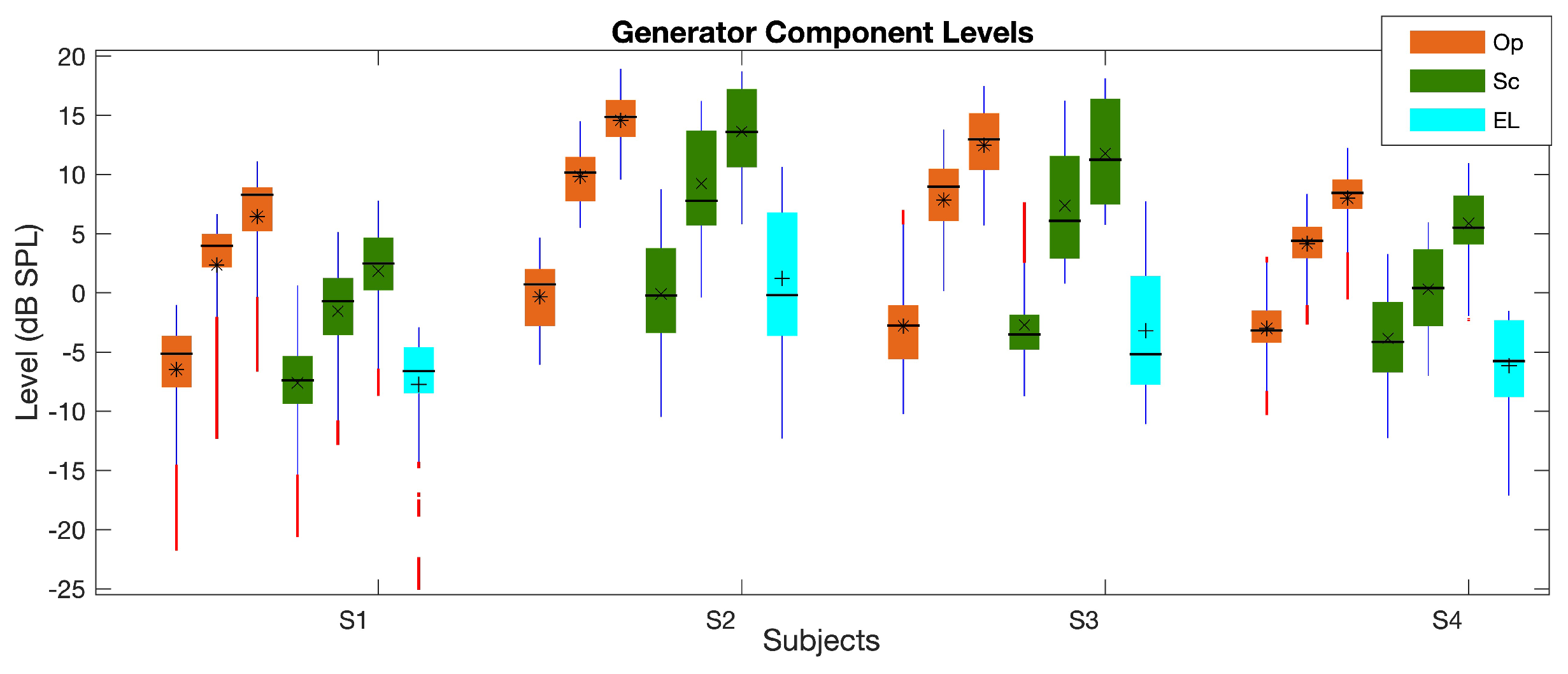

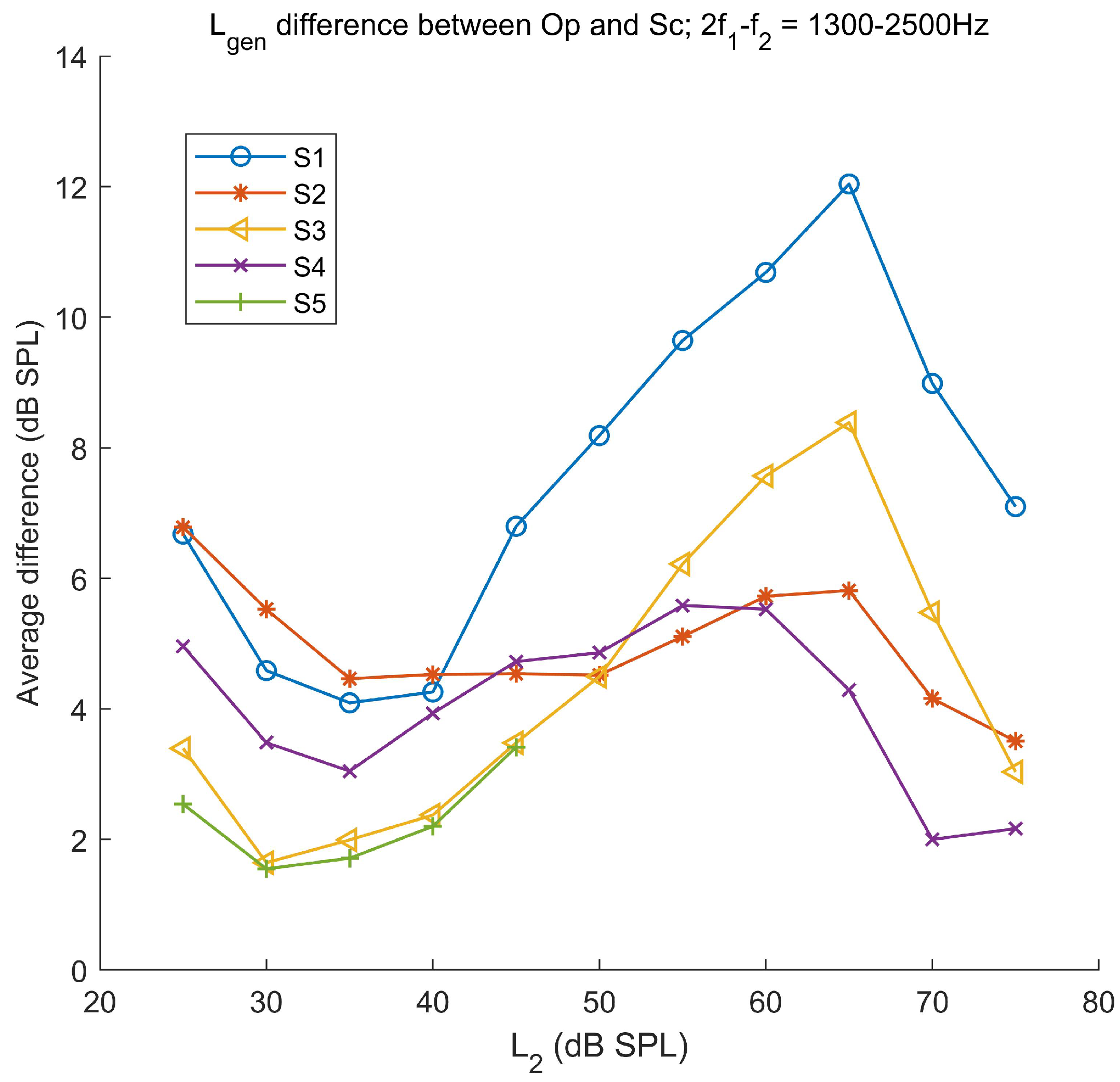

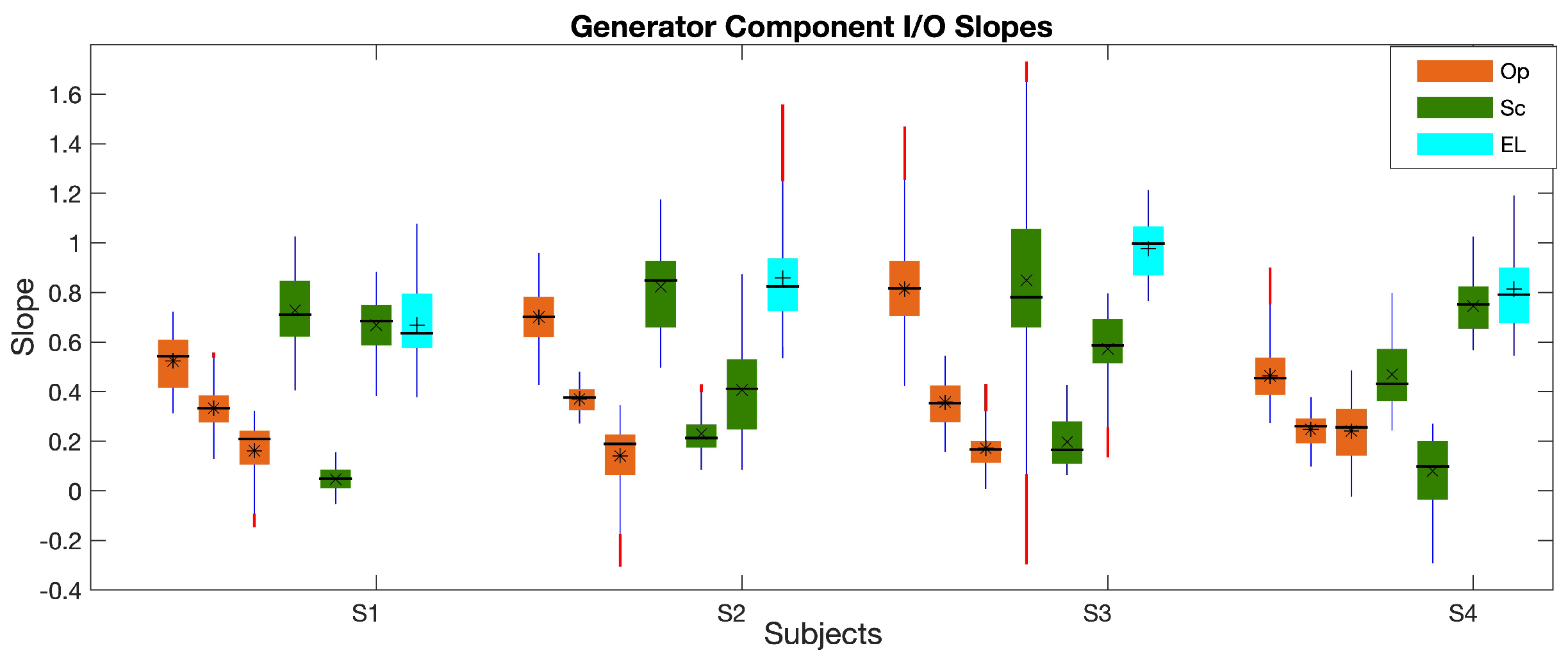
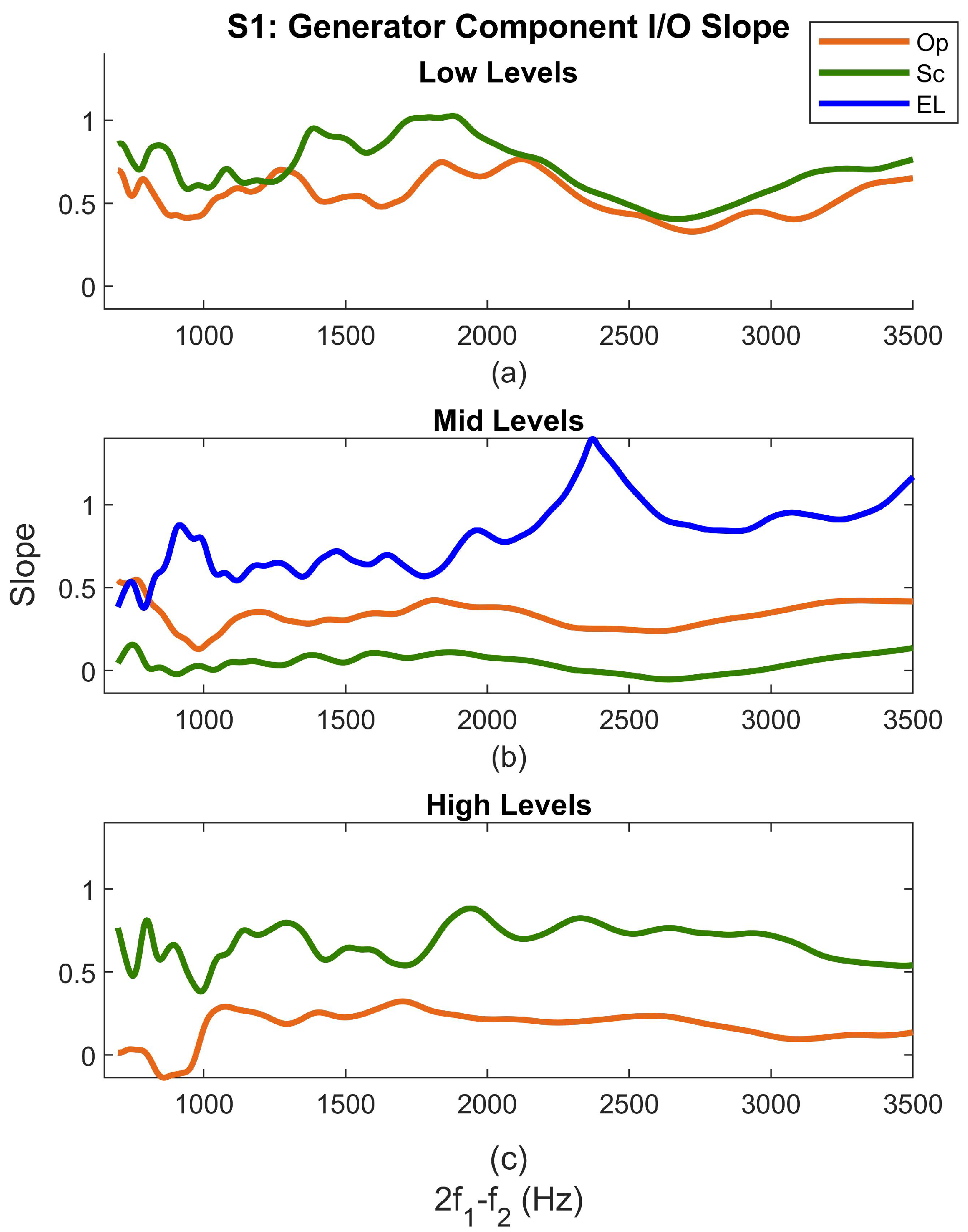

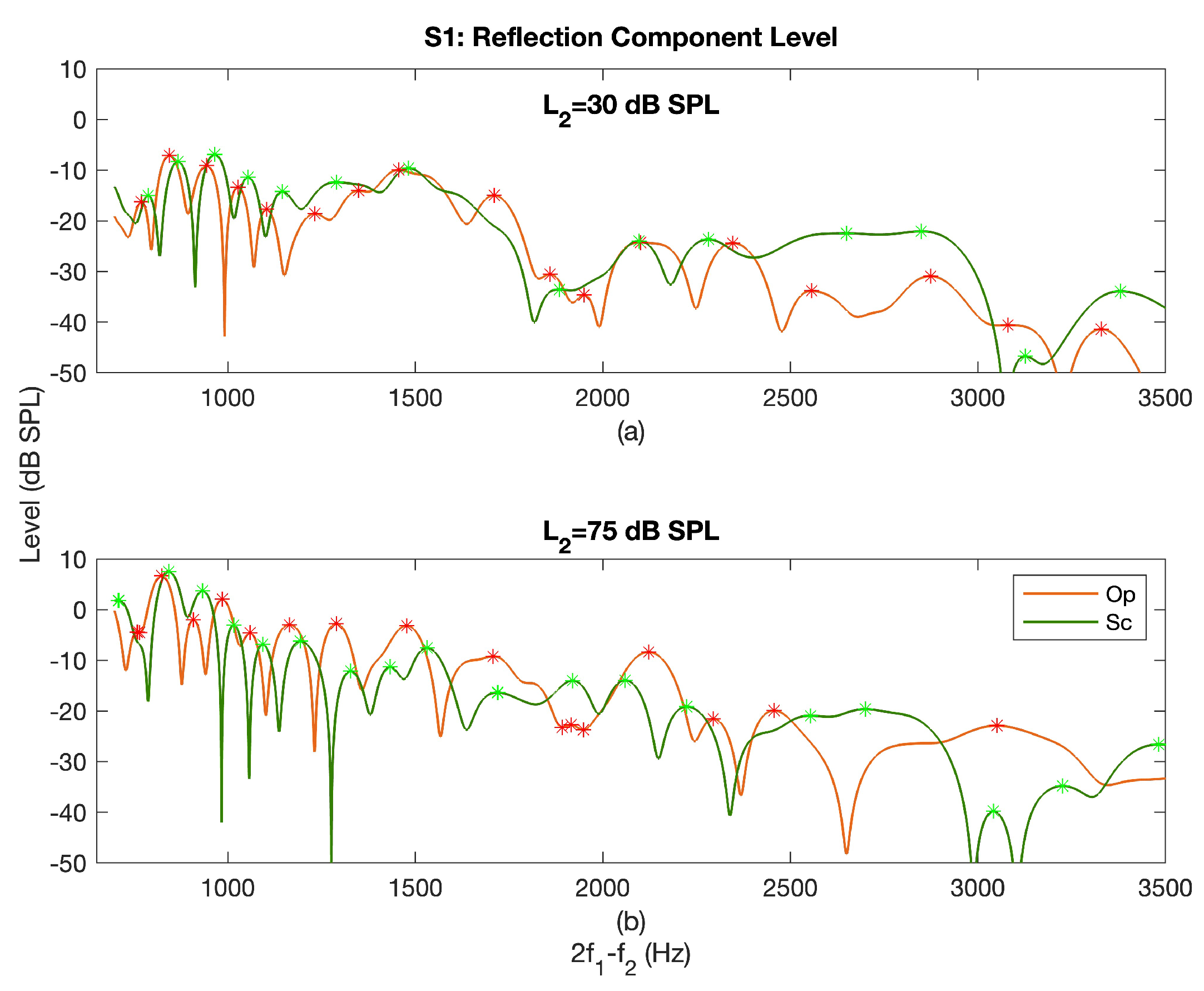

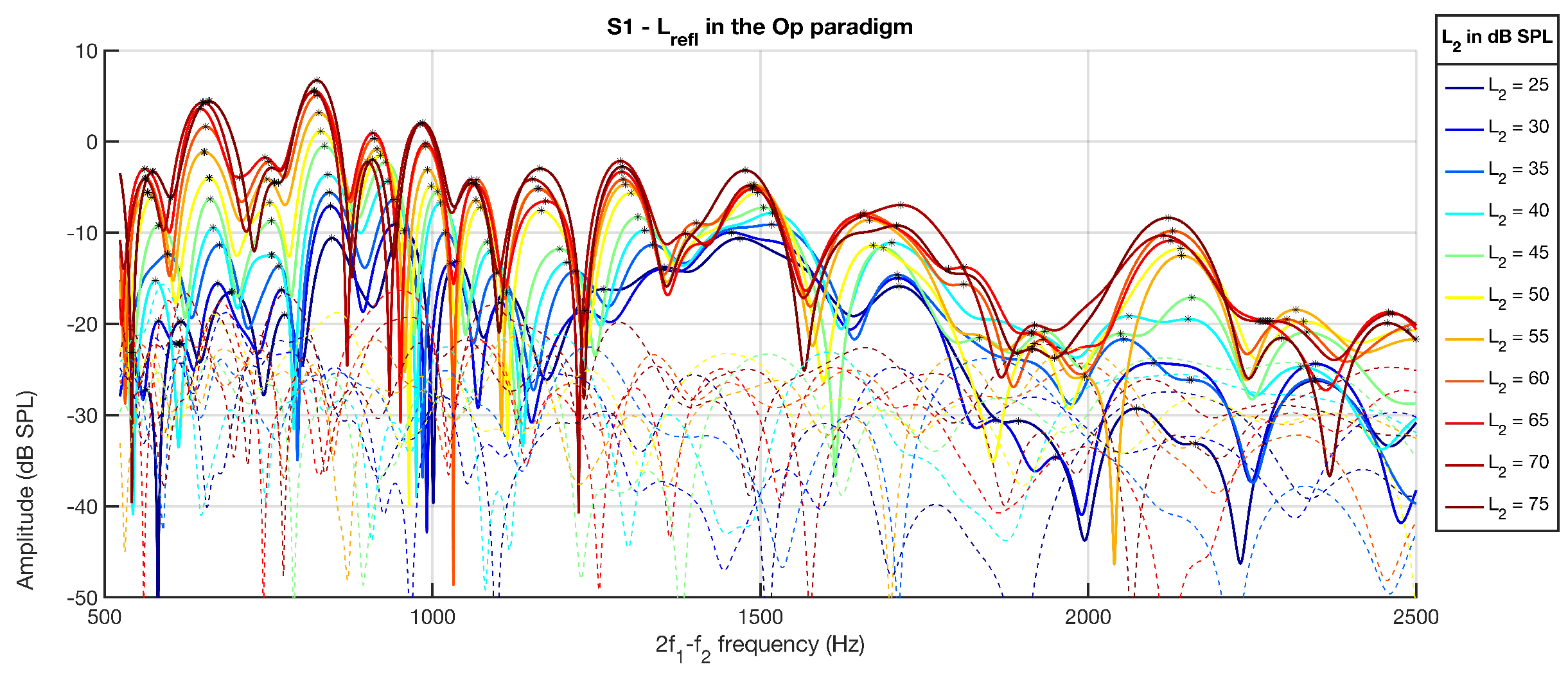
| Paradigm | Level Relation | ||
|---|---|---|---|
| Op | dB SPL | 25–75 dB SPL | 750–6000 Hz |
| Sc | dB SPL | 25–75 dB SPL | 1000–8000 Hz |
| EL | 40–75 dB SPL | 1000–8000 Hz |
Disclaimer/Publisher’s Note: The statements, opinions and data contained in all publications are solely those of the individual author(s) and contributor(s) and not of MDPI and/or the editor(s). MDPI and/or the editor(s) disclaim responsibility for any injury to people or property resulting from any ideas, methods, instructions or products referred to in the content. |
© 2023 by the author. Licensee MDPI, Basel, Switzerland. This article is an open access article distributed under the terms and conditions of the Creative Commons Attribution (CC BY) license (https://creativecommons.org/licenses/by/4.0/).
Share and Cite
Naghibolhosseini, M. The Effect of Stimuli Level on Distortion Product Otoacoustic Emission in Normal Hearing Adults. Acoustics 2023, 5, 72-86. https://doi.org/10.3390/acoustics5010005
Naghibolhosseini M. The Effect of Stimuli Level on Distortion Product Otoacoustic Emission in Normal Hearing Adults. Acoustics. 2023; 5(1):72-86. https://doi.org/10.3390/acoustics5010005
Chicago/Turabian StyleNaghibolhosseini, Maryam. 2023. "The Effect of Stimuli Level on Distortion Product Otoacoustic Emission in Normal Hearing Adults" Acoustics 5, no. 1: 72-86. https://doi.org/10.3390/acoustics5010005
APA StyleNaghibolhosseini, M. (2023). The Effect of Stimuli Level on Distortion Product Otoacoustic Emission in Normal Hearing Adults. Acoustics, 5(1), 72-86. https://doi.org/10.3390/acoustics5010005






